The United States Army Camel Corps 1856-66
By John Shapard
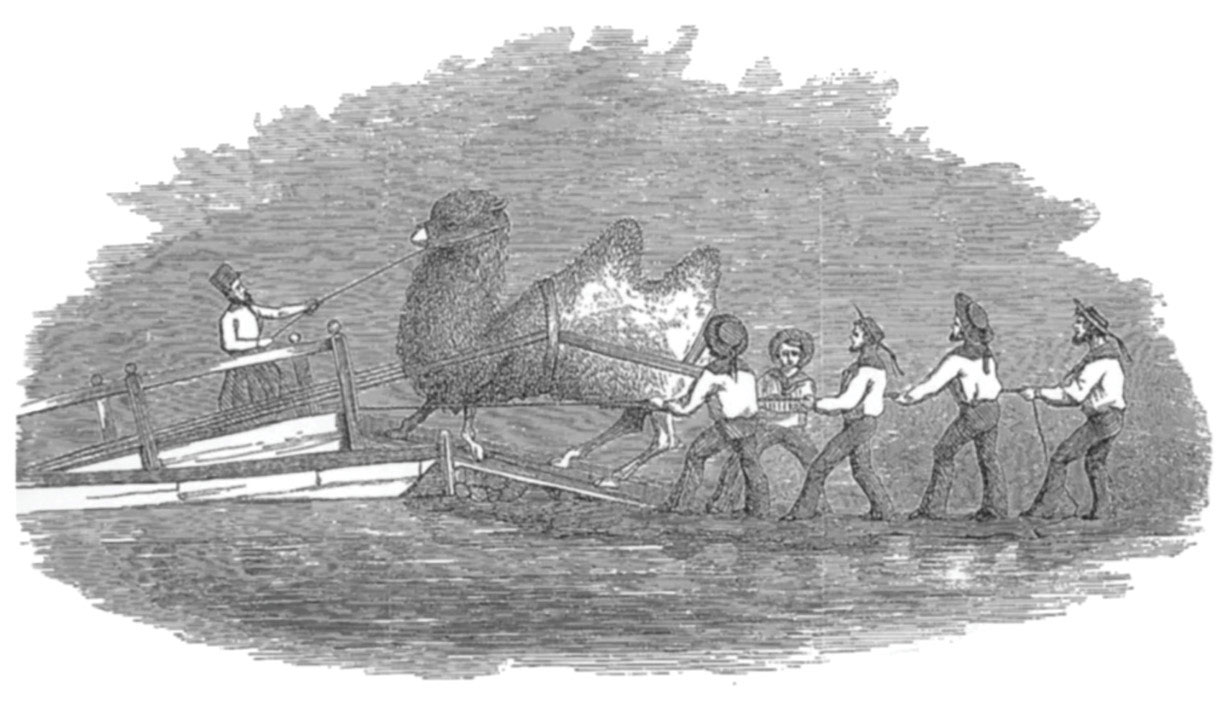
The embarkation of a Bactrian on the USS Supply. Since Artist Heap took the trouble to record the loading of this particular animal, it is possibly the gigantic Bactrian that required Lieutenant Porter to modify the Supply. (Drawing by G. Wynn Heap, artist with the first expedition to acquire camels from the Mid·East. From Reports Upon the Purchase, Importation and Use of Camels and Dromedaries, 1855-’56-’57.)
On 10 May 1855, Secretary of War Jefferson Davis personally penned one of the most unusual orders in the US Army’s history to Brevet Major Henry C. Wayne. It read, in part:
Sir: [You are] assigned to special duty in connection with the appropriation for importing camels for army transportaion and for other military purposes….1
The order represented a victory for Davis in a four-year struggle with Congress to establish a camel corps within the US Army. As a US Senator, he introduced the measure in Congress in 1851 and 1852, only to have it literally laughed out of committee on both occasions.2
An American came1 corps was initially suggested by Major George Crosman in 1837.3 The idea was ignored at the time, but, in 1848, two events combined to resurrect the camel project. The Treaty of Guadalupe Hidalgo, signaling the United States’ victory over Mexico, added over one-half million square miles of new lands, including the vast deserts of the Southwest, to the country’s real estate.4 Almost simultaneously, the discovery of gold in California sent thousands of immigrants streaming across the new territory. To the tiny 42,000-man US Army fell the duty of keeping the peace between the ever increasing flood of settlers and the almost 100,000 Indians who inhabited the region.5 The southwestern deserts presented special problems to the cavalry horse and supply mule Army of the 1850s. Military operations either ranged from water hole to water hole, or grain supplies and water casks had to be transported, reducing both the speed and the range of cavalry units. On the other hand, the desert Indians could travel without supplies. Living off the inhospitable land and covering as much as 100 miles in a 24-hour day, they found water in places unknown or inaccessible to the less mobile Army units.6
Major Wayne, who saw these problems while in the Southwest during the Mexican conflict, became the leading military advocate for a camel corps to be used in the desert regions of the country. He suggested the corps to a close personal friend with some influence, Senator Jefferson Davis from Mississippi. Davis. who as a colonel also saw the problems of desert warfare in Mexico, immediately sought funds for a test project. Finally, four years later as Secretary of War, he secured a $30,000 appropriation for the acquisition and testing of a small camel herd.7
A joint Army-Navy operation was put into motion. Major Wayne was in charge of the selection and purchase of the camels. Lieutenant David Dixon Porter, a 42-year-old Naval officer, was assigned the task of safely transporting the animals to the United States. Porter, the son of a US diplomat, was raised in the Mid-East and was familiar with the problems of camel care. He took several precautions to ensure success of the mission. A 60-foot camel barn with individual stalls was constructed on the spar deck of the USS Supply. A special hatch was cut in the top deck to accommodate the huge beasts, and a novel forced-air ventilation system was developed which sent fresh air pouring out of the ship’s sails into two specially designed hatches and out individual ports situated in each stall. A harness system was devised to hold the camels secure in rough weather, and a unique camel car was developed for loading and unloading the animals.8
Wayne, after examining the preparations, left ahead of Porter for England on 19 May to “visit persons whom it would be desirable to consult on points connected with this special service.”9 The energetic major visited the British Zoological Gardens, studied the camels there and took a quick course in the feeding and care of the shaggy animals from M. S. Mitchell, Secretary of the Royal Zoological Society.
Moving on to Paris in early July, Wayne discussed his mission with the French Secretary of War, Marichal Le Vaillant, and, through Le Vaillant, made valuable contacts in the French Camel Corps.
Meanwhile, Lieutenant Porter completed refurbishing the USS Supply and set sail for La Spezia, Italy, where he rendezvoused with his Army counterpart. The two sailed for Tunis immediately, and, upon arriving there on 4 August 1855, they began their search for America’s camels. In the next seven months, Wayne and Porter visited Alexandria and Cairo, Egypt, and Constantinople and Smyrna, Turkey. Their only difficulty occurred in Egypt where there was an express prohibition against the removal of any animals from the country without governmental approval. At first, the Egyptian viceroy refused to allow the exportation of any camels because it would set a “precedent for demands of a similar nature” from consuls of other countries.10 However, persuasive arguments by the major and a gift of two US Minié rifles convinced the viceroy to allow the exportation of 10 camels, including six from his own dromedary herd.

Drawing illustrating the need to train camel cavalrymen to fight on foot. The trooper is firing from behind sandbags. The Egyptians preferred to protect the camel rather than use the animal as cover and face the possibility of losing the animal and being stranded on foot in the desert. (Letter of W. Re Kyan Bey, Secretary to the Viceroy of Egypt to Edwin DeLeon, U.S. Consul General in Egypt on the Treatment and Use of the Dromedary.)
Wayne and Porter sailed for America with 33 camels on 11 February 1856. They had been careful to select their stock from a wide range of countries and from different breeds in order to compare the adaptability of the animals to the American climate. Nine of the 33 beasts were dromedaries or Arabian camels, the fast, mobile, one-humped variety; 23 were the large, more powerful, Bactrian, two-humped type. One was a hybrid. Wayne’s prize acquisition, a 2000 pound, 7-foot-4-inch Bactrian, was so large that Lieutenant Porter was forced to modify the Supply again to accommodate the huge beast by cutting a large hole in the deck to allow the animal’s giant humps to protrude through.11
The two officers now faced the problem of getting their valuable cargo back to the United States alive. It was no small task. Some of the animals had been aboard the ship for almost five months before the Supply departed Smyrna. The trip home would take another 87 days. As it turned out, the voyage, although stormy, was uneventful, and, on the morning of 14 May 1856, 34 camels (including one newborn calf) safely reached Indianola, Texas. Wayne described the scene:
On being landed, and feeling once again the solid earth beneath them, the camels became excited to an almost uncontrollable degree, rearing, kicking, crying out, breaking halters, tearing up pickets, and by other fantastic tricks demonstrating their enjoyment of the liberty of the soil.12
Through the strenuous efforts of the attending troops, Wayne managed to get his unruly camels stabled by eight that evening.
Only $8000 of the $30,000 appropriated for the project had been spent on the trip, and, almost as soon as the camels were unloaded, Lieutenant Porter was ordered to return to the Mid-East for more animals. He left by the end of July and returned on 30 January 1837, six months later, with an additional 41 Bactrians and dromedaries.13 The US Army now had its Camel Corps—75 animals strong.
While Porter was on his second trip, Wayne began testing the original 34 animals. The objectives of the tests were twofold. First, the Army wanted to determine the combat capabilities of the animals. A camel cavalry and mounted infantry and artillery units were envisioned. Second, and more important in the minds of top officials, was the transportation potential of the beasts. The camel was viewed as a possible solution to the mind-boggling costs and lengthy time element involved in supplying military posts in the new territory. Jefferson Davis personally hoped that the tests would establish the commercial benefits of shipping goods by camel.
The camels’ home base was established at Camp Verde, Texas, 60 miles north of San Antonio. Here, Wayne informally outlined his plans for the testing:
The burden animals can be used for transporting supplies from San Antonio to the camp and to other points. The dromedaries may be sent express anywhere along the frontier or within the settlements, as necessity may require, and may be used as pack animals to scouting parties instead of mules. In some cases men may be mounted with a small gun throwing shrapnel…. These experiments may be so conducted as not only to show the absolute value of the animal for burden and for the saddle, but also a relative usefulness in comparison with the horse, the mule, and waggoning.14
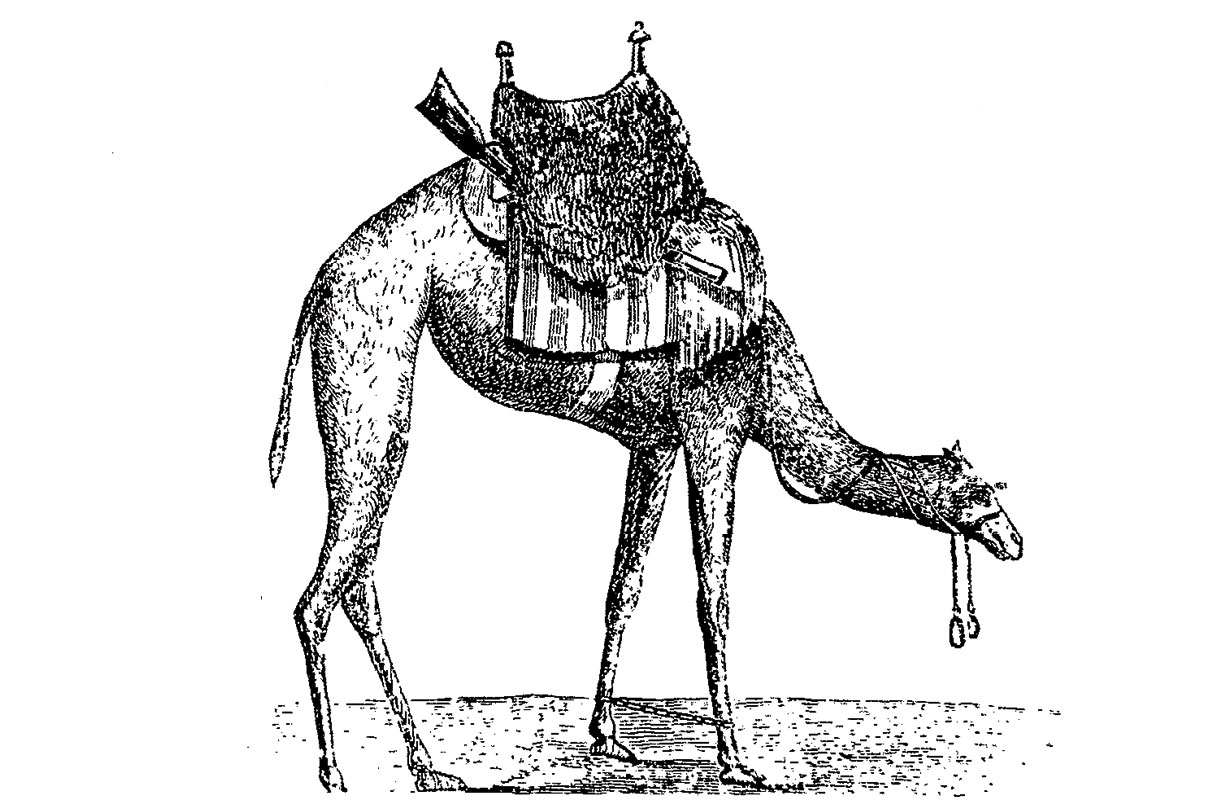
A tethered camel cavalry mount with saddle. The camels were trained to keep their head in a lowered position to give the cavalryman an unrestricted range of movement and an unlimited field of fire. (Letter of W. Re Kyan Bey, Secretary to the Viceroy of Egypt to Edwin Deleon, U.S. Consul General in Egypt on the Treatment and Use of the Dromedary.)
To ensure Presidential interest in the camel project, Major Wayne sent Secretary of War Davis a special package for delivery to President Buchanan. The attached letter read:
I have the honor to enclose herewith a pair of socks knit for the President by Mrs. Mary A. Shirkey, of Victoria, Texas, lately of Virginia, from the pile of one of our camels.15
Whether the President actually wore his camel’s-hair socks goes unrecorded.
Through Wayne’s thorough testing program, it was soon apparent that the noble animal was simply not suited to the American style of combat. The configuration of the camel’s nose, while admirably designed to filter out blowing sand, impeded breathing during violent exertion, and the camel’s lung capacity was such that it could not maintain a sustained rapid pace or violent action. Under extreme excitement, the animal would blow the buccal membrane which normally hangs in the pharynx, balloon fashion, from its mouth, further reducing its air supply, Another serious disadvantage in combat was the fact that the camel, unlike the horse, was unwieldy in close situations.16
Notwithstanding all of this, the most troublesome drawback to the combat usage of the camel was the resistance of both men and officers to the animal. Compared to the horse, the camels required an extraordinary amount of care. Without it, they developed a severe form of the mange which was highly contagious, unsightly and difficult to cure. What is more, the camel, at best, smelled different from the horse—at worse, he simply stank. Even after the troopers adjusted to the smell, the camels had three habits to which the men would not reconcile themselves. Although generally docile, the camels could be stubborn, and, if disciplined for their stubbornness, they would often vomit their cuds on the disciplinarian. This and the camels’ ability to defecate without any warning whatsoever to anyone standing to their rear quickly overrode whatever lovable or useful qualities they may have possessed. What is more, the shaggy creatures could deliver a vicious bite when annoyed with their keeper. Finally, the troops, almost to a man, complained of motion sickness after riding the animals for any distance or at a gallop.17
If the camels gave the troops a difficult time, there is good evidence that the men returned the favor with interest. Wayne wrote on 22 July 1856:
It is with regret that I report the death of one of our best female camels from Smyrna … this one strayed, and when hunted up was found about two miles off, lying upon its side and evidently very ill. It was brought into camp carefully under the personal superintendence of Mr. Ray, and there, after lingering several hours, died. Its death was supposed to be inflammation of the bowels, but after death an examination was made by Dr. A. Z. Herman, M.D., a physician living in the neighborhood, who discerned that the animal had been killed by one or more heavy blows … as the animal was gentle, I can hardly think the act one of self-defence.18
One week later, Wayne reported another mysterious death, and, in November, two more.
Finally, after a series of incidents, a rash of complaints and a series of tests, Wayne unhappily reported that the combat usage of the camel in America was not feasible.19
If the camel was a failure for the Americans as a combat animal, it was a godsend for quartermaster units, then in charge of supply transportation. Ordinary dromedaries could easily carry a 550-pound load, slightly more than twice what a common pack mule was expected to carry. The larger dromedaries could comfortably pack 700 to 800 pounds and, on occasion, would carry as much as 1000 pounds for short distances.20 The larger and stronger Bactrians could carry close to three-fourths of a ton with ease.
In February 1857, Wayne staged a demonstration for the doubting public. He wrote of the incident:
Needing hay at the camel yard, I directed one of the men to take a camel to the quartermaster’s forage-house and bring up four bales. Desirous of seeing what effect it would produce on the public mind, I mingled in the crowd that gathered around the camel as it came to town. When made to kneel down to receive its load and two bales, weighing in all 613 pounds, were packed on, I heard doubts expressed around me as to the animal’s ability to rise under them: when two more bales were put on, making the gross weight of the load 1,236 pounds, incredulity as to his ability to rise, much less to carry it, found vent in positive assertion … to convey to you the surprise and sudden change of sentiment when the camel, at the signal, rose and walked off with his four bales of hay, would be impossible.21
Wayne not only proved that the camels’ payload was larger than the pack mules; but he also established their advantages over the mule-drawn wagon. The major first successfully pitted camels against wagons in September 1856. He recorded the experiment in his report to Jefferson Davis: “I sent down six camels under my clerk, Mr. Ray, to San Antonio, for oats, in company of wagons from this post….” Both the wagons and the camels were timed, and their loads were carefully measured. The camels won easily. Wayne noted the results with satisfaction:
From this trial it will be seen that the six camels transported over the same ground and distance, the weight of two six mule wagons, and gained on them 421/2 hours in time.22
Wayne also successfully tested the concept of camel support for cavalry units:
Lieutenant Chablis [sic] went out with a small party, and with him I sent a dromedary to transport the provisions and forage [corn] for the men and horses, seven each. The next day he returned and from his report, and that of his men, the trial was very successful, the dromedary following the horses wherever they went, not only keeping up with them, but showing that if not restrained, he would have gone ahead of them. The weight transported was between 300 and 400 pounds.23
By October 1856, Major Wayne expressed the belief that he had conclusively proved the camels’ worth for both military and civilian cargo transportation in the Southwest. He wrote:
The usefulness of the camel in the interior of the country is no longer a question here in Texas among those who have seen them at work, or examined them with attention.24
With his task apparently at an end, Wayne was transferred from the project in January 1857 to The Adjutant General’s staff in Washington. Before leaving Camp Verde, however, he recommended a large-scale field trial of the camels which would prove the value of the humped creatures once and for all in the minds of the public and the Congress. Enthusiastic officials in the War Department liked the idea, and 25 camels (both dromedaries and Bactrians) were included with the military survey expedition scheduled to map a wagon road from Fort Defiance, Arizona, to the Colorado River.
No more severe test of the camels’ worth could have been proposed. The bone-dry route stretched from the barren Texas plains, across the Sandia Mountains, into the New Mexican wastelands to Fort Defiance. From there, the route led through Arizona’s high desert and petrified forest areas and directly down into the scorching Mohave Desert.
President Buchanan personally appointed a former Navy lieutenant turned explorer, Edward Fitzgerald Beale, to lead the survey. On 25 June 1857, the expedition, complete with 46 mules, 250 sheep (for delivery to Fort Defiance) and 25 camels, surged westward from Camp Verde.
The camels assigned to Beale were only recently off the boat, having been acquired by Lieutenant Porter during his second voyage to the Mid-East, and Beale was initially disappointed with their performance. On 26 June, the second day out, he wrote in his daily journal:
Thus far, the camels have not been able to keep up with the wagons, but I trust they will prove better travelers as they become more accustomed to the road.25
Two weeks later, however, Beale wrote with growing confidence in the animals, “The camels are now keeping up with the train, and come into camp with the wagons.”26 As the days continued to pass, Beale’s appreciation of the camels grew. After traveling on a gravel road for several days in late July, the lieutenant commented:
It is a subject of constant surprise and remark to all of us, how their feet can possibly stand the character of the road we have been traveling over for the last ten days. It is certainly the hardest road on the feet of barefooted animals I have ever known….27
A few days later he wrote:
The camels are traveling finely…. It is worthy of especial note [that] I have never seen or heard of one stumbling, or even making a blunder.28
By 6 September, two and one-half months out, Beale could not contain his optimism for the tireless camels:
Certainly there never was anything so patient and enduring and so little troublesome. They pack their heavy load of corn [Beale had the animals loaded with 750-1,000 pounds each] of which they never taste a grain; put up with any food offered them without complaint and are always up with the wagons; withal, so perfectly docile and quiet that they are the admiration of the whole camp.29
The most severe test of the entire journey for the camels occurred in September 1857 somewhere near the vicinity of the modern town of Winslow, Arizona. The expedition was virtually out of water, unsure of their location and led by an inept scout. Beale recorded the incident:
Our guide … came back to tell that the distant mountain towards which our course was directed, was not the one he thought and that he was completely lost. I ought to have killed him there, but I did not.30
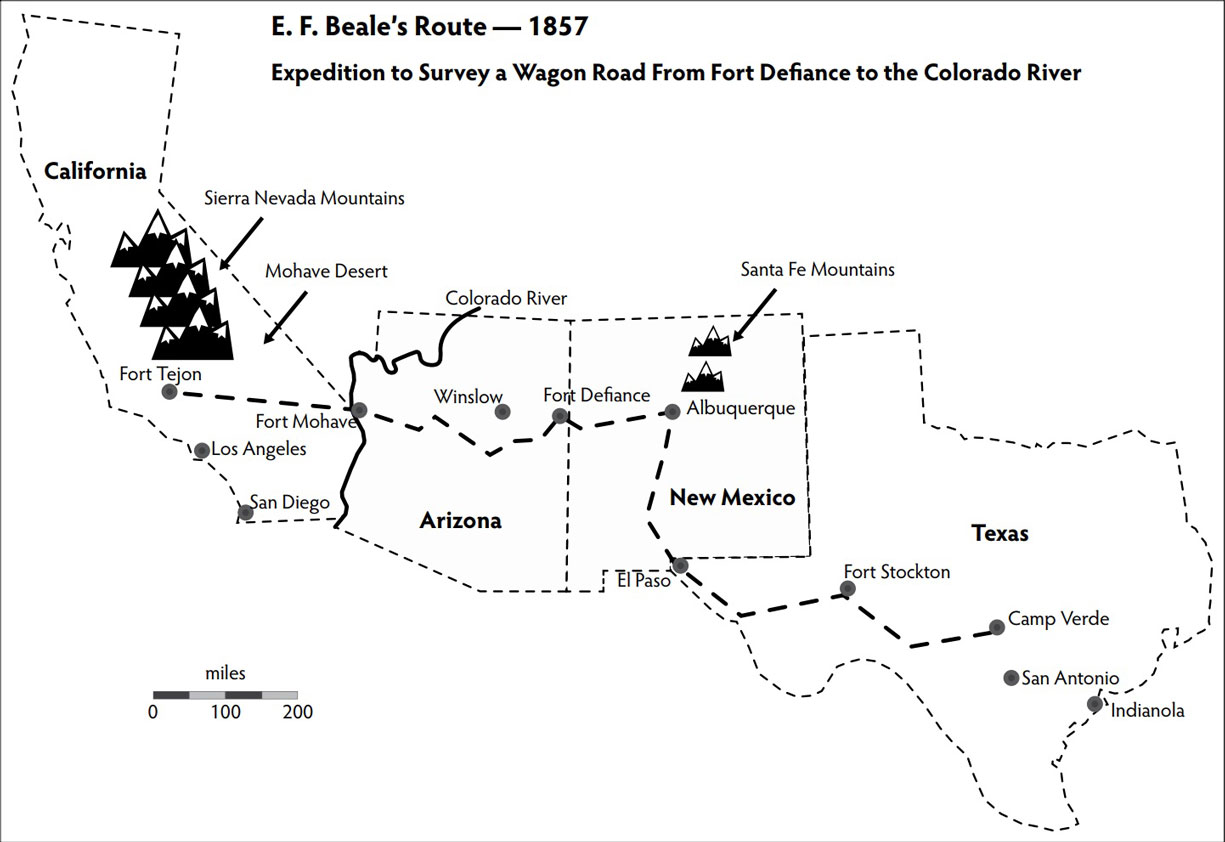
Expedition to Survey a Wagon Road from Fort Defiance to the Colorado River.
Beale set up dry camp on the evening of 19 September. The expedition was 20 miles from the nearest known water. As the troops broke out a small keg of water for the animals, Beale observed:
Our animals were now beginning to suffer very much, having been almost constantly at work for 36 hours without ,eater; and one of the most painful sights I have ever witnessed was a group of them [the expedition’s mules] standing over a small barrel of water and trying to drink from the bung hole, and seemingly frantic with distress and eagerness to get at it. The camels appeared to view this proceeding with great contempt, and kept quietly browsing on the grass and bushes.31 The mules were saved the next morning when Beale set them free and they raced, full gallop, back to the last known water hole. Beale ended his mission on 18 October when the strange caravan reached the Colorado River. He then herded the camels to Fort Tejon, California, where they were stabled at a nearby camp, only a few hundred yards from the summit of the Sierra Nevada Mountains “for’ the sake of testing their capability of withstanding cold.”32
After a brief stay in the Golden State, Beale packed up several of the camels and retraced his trail eastward in order to test “the practicability of the road surveyed last summer for winter transit.”33 He reached Fort Defiance on 21 February 1858, ending the Camel Corps’ first and only major expedition. The camels’ unqualified success as cargo transports convinced the new Secretary of War, John B. Floyd, of their value, and, after receipt of Beale’s report, he proclaimed, “The entire adaptation of the camels to military operations on the plains may now be taken as demonstrated.” Floyd enthusiastically requested an appropriation in 1858 for the purchase of 1000 camels.34 The request was not acted upon, but Floyd tried again in 1859. By that time, however, the request was lost in a Congress preoccupied with the tensions between the North and South. When the Civil War was finally declared in 1861, the Federal camel herd was located at two widely separated posts, 80 animals at Camp Verde, Texas, and 31 at Fort Tejon, California.
For reasons unknown, the results of the camel tests went unheeded, and the Union considered the animals a liability. The Confederacy, however, assumed the bulk of the burden from their Northern brothers when they captured Camp Verde on 28 February 1861. The remaining 31 Union camels at Fort Tejon languished at the post, used only for modest hauling purposes and for mail transportation in the vicinity of the fort.
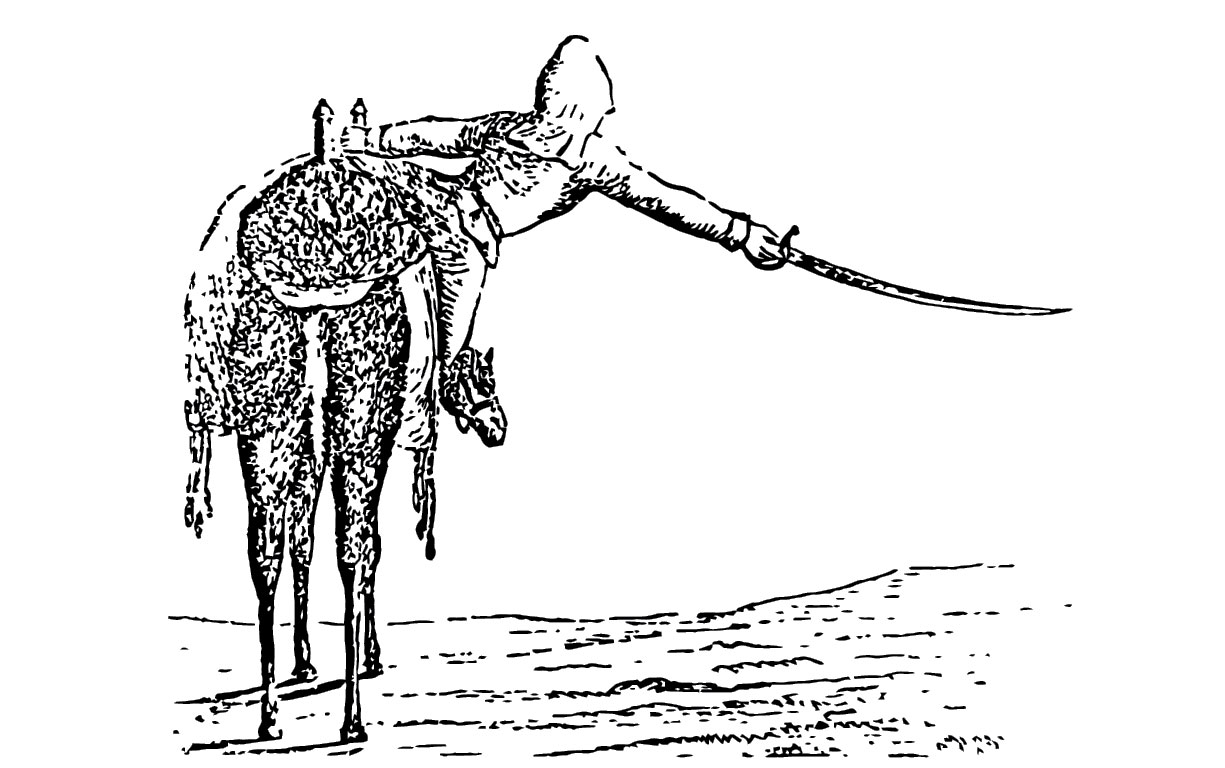
One advantage of the camel over the horse was the ability of the rider to make a more extensive saber cut by holding the frontpiece of the saddle and leaning to the side. (Letter of W. Re Kyan Bey, Secretary to the Viceroy of Egypt to Edwin DeLeon, U.S. Consul General in Egypt on the Treatment and Use of the Dromedary.)
The Confederacy attempted to make better use of the captured animals. Confederate Genera1 Magruder’s Quartermaster Department relied heavily on the Camel Corps. One officer, Captain Sterling Price of the Noxubee County, Mississippi, infantry managed to acquire one of the beasts and used it throughout the war to carry his entire company’s baggage.35
Despite the Confederate Government’s positive attitude toward the Camel Corps, the smelly brutes were just as unpopular with Johnny Reb as they were with his Federal counterpart. There were several recorded instances of malicious killing of the animals by Confederate troops. Cuba Blanks, a slave in Texas during the war, admitted, after much coaxing from a professional journalist in the 1930s, that he helped several” of the boys in gray push a camel over a cliff because the beast was “naturally hard to get along with.”36 He also claimed to have seen another soldier kill a camel with a dirk.
The Union camels in California fared only slightly better. After being named a public nuisance in a law suit because of their odor, and, after repeated complaints from the officers at Fort Tejon that the camels were useless, expensive and troublesome, the entire herd, numbering 37 (including births), were sold at public auction, in San Diego on 24 February 1864. Circus owners purchased most of the animals. A few went to prospectors, and some were purchased by 86 ranchers. The Confederate camels were ultimately reacquired by the United States after the war, and, within a year, the Army and Navy Journal wrote the obituary for the US Army Camel Corps in an article entitled, “Camels”:
The Camels are going. They are going at auction. It will be remembered that, before the war, under Floyd’s gentle administration of the War Department, the Government imported a large number of camels, and sent them to Texas, for the purpose of transporting supplies over the plains in the western part of that state. Their career is now run, and they are to be sold at auction. We believe that they once went across to San Diego, and returned through Arizona to San Antonio.
When the Rebellion broke out, they seceded, but unlike most of the Confederate quadrupeds, the survivors were not exempted from surrender as ‘private horses of officers’ in the grand series of capitulations. This latter fact is more remarkable, as some animals much less resembling the ordinary models of an officer’s horse escaped capture on the grounds of being such. Accordingly these camels were transferred from General Kirby Smith to General Canby. They had been employed for transportation in the Confederate Quartermaster’s Department under Magruder. The Government finding that it had drawn, if not an elephant, several camels, in the Confederate lottery, seems to have desired to get rid of the prize as speedily as convenient. Sixty-six of the camels are now at Camp Verde, near San Antonio, offered for sale by the Quartermaster of the Department of the Gulf. Bids for one or more of the animals will be received until the first of March, when the proposals will be opened at New Orleans. This is a fine opportunity for Mrs. Toodles to invest. They are so handy to have in the house.37
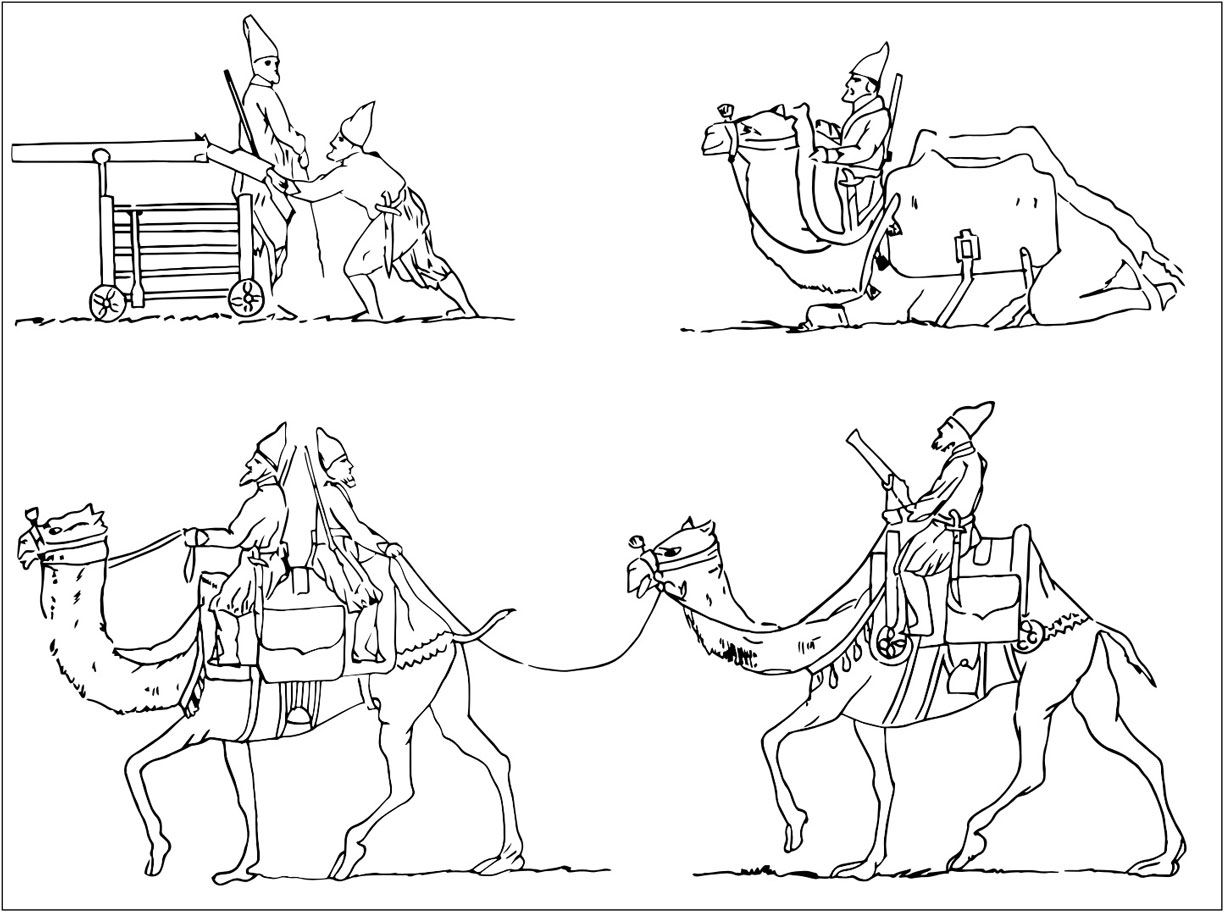
A camel artillery crew. The cannoneer of the right sponged, rammed down, primed and fired the piece. Cannoneer of the left purveyed, closed the pan and aimed. The number three cannoneer held the camels, served ammunition and assisted with purveying. Cannoneers two and three also served as mounted infantry to protect the piece while in transit and were used to lead the artillery camel in case of the necessity to fire from the saddle. Ammunition and rations for the crew were divided between the two camels and carried in the large saddlebags as shown. (From Zemboureks, The Persian Camel Artillery, translated by H. C. Wayne.)
The article told the tale. Except for a handful of dedicated individuals, few people ever took the camels seriously—not even to the last. There is no question that the Army’s Camel Corps, during the period 1856-66, was a failure.
John Marsh, Minister to Constantinople, foresaw the cause for that failure as early as 1854 when he wrote:
If the experiment shall fail it will neither be because the attempt is in its nature hopeless, nor because the public agent entrusted with the charge of it has committed any error in the execution of his duties, but because the means appropriated by Congress did not admit of an experiment on a scale extensive enough, and varied enough, to embrace all of the reasonable chances of success.38
Adequate funds were never forthcoming. Henry Wayne predicted in 1857 that it would take 10 years to establish the camels in this country and to prove their value to the public. Three and one-half years later, the Civil War, not camels, consumed both the country’s funds and the public mind. By the end of the war, the railroad and all-weather roads were the order of the day, and the camels were no longer needed.
Not all of the blame, however, can be placed with the Congress nor can it be attributed to the Civil War. The failure of the 1856 camel experiment was in a large part—if not entirely—due to the lack of acceptance by both men and officers and to public indifference toward the project. It was a 19th-Century demonstration of the need to indoctrinate personnel carefully into a new and innovative system. The Camel Corps also provides a historical lesson on the need to develop and maintain a well-coordinated public relations program to inform and educate the general public and the Congress about new programs and systems.
Clearly, if the Camel Corps had enjoyed the unreserved support of military personnel and the public, it could have saved hundreds of thousands of dollars in the development of the Southwest and considerably shortened the 38-year conflict with the Indians in the region.
Notes
1. Reports Upon the Purchase. Importation and Use of Camels and Dromedaries. 1855-’56-’57, US Congress. Senate Executive Document Number 62, Committee on Military Affairs, 34th Congress, Third Session, Washington. D. C., 1857, p 13, Letter from Jefferson Davis to Major Henry C. Wayne, 10 May 1855.
According to Francis B Heitman, Historical Register and Dictionary of the United States Army From Its Organization, September 29, 1789 to March 2, 1903. Superintendent of Documents, US Government Printing Office. Washington, DC. 1903, Volume I, pp 358 and 1010, Jefferson Davis was born in Kentucky and graduated 23d in his class from the US Military Academy on 1 September 1824. He was commissioned as a colonel in the 1st Mississippi Rifles until 12 July 1847 when he resigned his commission Davis was Secretary of War from 7 March 1853 to 6 March 1857. He later became President of the Confederate States, serving from 1861 until 1865. Henry C. Wayne was born in Georgia. He graduated 14th in his class from the US Military Academy on 1 July 1834. He was promoted to brevet major on 20 August l847 for gallant and meritorious service in the Battles of Contreras and Churnbusco, Mexico. He resigned his commission on 31 December 1860 to serve in the Confederate Army as a brigadier general.
2.The Congressional Globe, US Congress, 32d Congress, First Session, 1852, Volume 21. p 2430.
3. “Camels: The Story of a Long Ago Experiment,” Indians at Work, February 1919, pp 28-30. According to Heitman, op. cit, p 341, George Crosman was born in Massachusetts, graduated from the US Military Academy on 1 September 1819, and was promoted steadily until his retirement in 1866. He received brevet promotions for gallant conduct during the Battle of Palo Alto, Texas, during the Mexican War. He was promoted to major general on 13 March 1865 for faithful and meritorious service during the Civil War. He died on 28 May 1882.
4. William M Malloy, Treaties, Conventions, International Acts, Protocols, and Agreements Between the United States of America and Other Powers, 1776-1909, Superintendent of Documents, US Government Printing Office, Washington, D. C., 1910, Volume I. pp 1107-21.
5. Report of the Commissioner of Indian Affairs, Superintendent of Documents, US Government Printing Office. Washington, D. C., 1852, Appendix, and Jack Bauer, The Mexican War, 1846-1848. The Macmillan Co. NY, 1974, p 397. This figure represents the Regular Army at the close of the Mexican War. An additional 73,000 men were in the volunteer ranks.
6. John G. Bourke, On the Border With Crook, The Rio Grande Press, Chicago, Ill, 1962, pp 35-38.
7. Reports Upon the Purchase, Importation and Use of Camels and Dromedaries, 1855-’56-’57, op. cit, p 7, Davis to James M. Mason, President pro tempore US Senate, 24 February 1857
8. Ibid., pp 106-7, Porter to Davis, 13 August 1855.
9. Ibid., p 13, Davis to Wayne, 10 May 1855.
10. Ibid., p 35, Wayne to Davis, 28 December 1855.
11. Commander Malcolm W. Cagle, “Lieutenant David Dixon Porter and His Camels,” United States Naval Institute Proceedings, December 1957, pp 1327-33.
12. Reports Upon the Purchase, Importation and Use of Camels and Dromedaries. 1855-’56-’57, op cit., p 98, Wayne to Davis, 14 May 1856.
13. Ibid., p 200. Captain W. C. Van Bokkelen to Davis, 30 January 1857.
14. Ibid., p 155, Wayne to Davis. 12 August 1856.
15. Ibid.
16. Letter of W. Re Kyan Bey, Secretary to the Viceroy of Egypt to Edwin Deleon, US. Consul General in Egypt on the Treatment and Use of the Dromedary, US Congress, Senate Miscellaneous Document Number 271, 35th Congress. First Session, Washington. D. C., 1857-58. p 33.
17. Ibid., pp 8-18; and Harland D Fowler. Camels to California, Stanford University Press, Stanford, Calif., 1950, pp 41-42.
18. Reports Upon the Purchase, Importation and Use of Camels and Dromedaries. 1855-’56-’57, op cit.,152, Wayne to Davis, 22 July 1856.
19. Ibid., p 195, Wayne to General Thomas S. Jesup, 12 February 1857.
20. Ibid., pp 72-75, Frederick Ayrtoun to Edwin DeLeon, 3 December 1857.
21. Ibid., p 197, Wayne to Davis, 21 February 1857.
22. Ibid.
23. Ibid., pp 159-60. Wayne to Davis, 5 November 1856. In Heitman. op. cit., p 294, the officer mentioned is Nathaniel Rives Chambliss of Virginia who graduated ninth in his class at the US Military Academy. He was dismissed from the Army on 25 May 1861 and served in the Confederate Army as a lieutenant colonel in the Ordnance Department. He died on 7 March 1897.
24. Reports Upon the Purchase, Importation and Use of Camels and Dromedaries. 1855-’56-’57, op cit., pp 159-60, Wayne to Davis, 5 November 1856.
25. Wagon Road From Fort Defiance to the Colorado River, US Congress, House Executive Document Number 124, 35th Congress, First Session, Washington, D. C., 1857-58, p 15. Beale kept a daily journal for the entire journey from Fort Defiance to California which Congress officially published in 1858.
26. Ibid., p 17.
27. Ibid., p 25.
28. Ibid., p 26.
29. Ibid., p 42.
30. Ibid., p 57.
31. Ibid.
32. Ibid., p 76.
33. Ibid., p 77.
34. Fowler, op. cit., p 68.
35. Cris Emmett, Texas Camel Tales, Naylor Printing Co., San Antonio, Tex., 1932, p 191.
36. Ibid., p 210.
37. “Camels,” Army and Navy Journal, 13 January 1866.
38. Fowler, op. cit., p 89.
